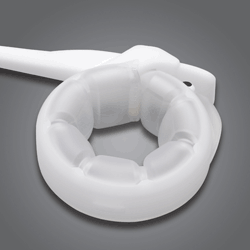Gastric Banding / Lap-Band Mobile, AL
 The Laparoscopic Adjustable Gastric Band also known by its trade name, Lap-Band, is an implant-based surgical solution for patients suffering from morbid obesity. The Lap-Band is unique in that it is the only surgical procedure approved for those with a BMI of 30 to 34.9 that may be suffering from one or more obesity-related diseases. All other bariatric procedures require a BMI of at least 35. As the name suggests, the Lap-Band is performed in a minimally invasive manner.
The Laparoscopic Adjustable Gastric Band also known by its trade name, Lap-Band, is an implant-based surgical solution for patients suffering from morbid obesity. The Lap-Band is unique in that it is the only surgical procedure approved for those with a BMI of 30 to 34.9 that may be suffering from one or more obesity-related diseases. All other bariatric procedures require a BMI of at least 35. As the name suggests, the Lap-Band is performed in a minimally invasive manner.
How The Gastric Band Is Performed
The gastric band consists of an implanted medical device that reduces the amount of food that can be consumed at any one time. During the procedure, the surgeon creates five tiny incisions in the abdomen through which specialized medical devices are passed. One of these devices is a small band made of a biocompatible silicon material that is placed around the top of the stomach. The inside of the band is composed of small pillow-like cells that will eventually receive saline. The surgeon will fill the band with this sterile saline to create restriction.
Once the band is tightened, it effectively splits the stomach into two chambers. The narrow passageway allows food to pass slowly and restricts the amount of food the patient can comfortably eat in one sitting.
The band is connected to a long thin silicone tube, which is, in turn, connected to an injection port that will be implanted in the abdominal wall, just under the skin. This injection port allows the surgeon to introduce or remove saline to tighten or loosen the band respectively.
Recovery And Results Of The Gastric Band
Gastric band patients typically spend one night in the hospital assuming an uneventful surgery and recovery.
The results of the gastric band are not as significant as the gastric bypass or gastric sleeve, however, the band does not alter the gastrointestinal system in any irreversible or permanent way. Typically, patients can expect to lose up to 55% of their excess body weight and resolve or improve many of the diseases associated with morbid obesity. Results will vary between patients.
Benefits Of The Gastric Band
- Adjustability, allowing patients to find the optimal restriction over time
- Reversible, although the patient should understand that removing the band will likely cause weight regain
- Very good excess body weight loss potential and obesity-related disease improvement potential
- Very few nutritional restrictions and lessened need for supplementation
- Significantly lower chance of dumping syndrome as compared to the gastric bypass
Risks And Considerations Of Gastric Band
- Patients should expect a lifelong implant
- Lower average excess body weight loss and disease resolution potential versus gastric sleeve or gastric bypass
- Band-specific complications that include esophageal erosion, band slippage, and flipping of the injection port, all of which require additional surgery
- The band does have a generally higher long-term complication rate versus stapled procedures
- Additional time is required for follow-up to achieve optimal restriction
- All the risks of major surgery including infection, blood loss, pain, and in rare cases, death
FDA approval of the gastric band has given those with milder obesity the option of bariatric surgery. It is important to note, however, that not all insurances will cover patients with BMIs of 30-34.9 for a gastric band. It is therefore very important to learn more about insurance coverage early in the process.
Watching our online seminar followed by a consultation with one of our surgeons is the best way to understand if the Lap-Band gastric banding options are appropriate for your particular circumstance.


 Related Information
Related Information